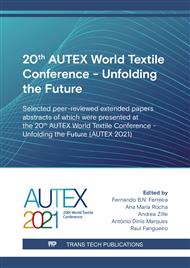[1]
Bernardes, J.P., Ferreira, F., Marques, A. & Nogueira, M. (2018). Generation Y's Sustainability attitude-behavior gap. CIMODE 2018 Conferencia Internacional de Moda e Design, Madrid, May.
Google Scholar
[2]
Bernardes, J.P., Ferreira, F., Marques, A., Nogueira, M. & Luca, A. (2018). Paper: The Generation Y's Sustainability Perceptions and Consumption Habits in the Footwear Industry in Portugal. In proceedings of the AUTEX 2018 World Textile Conference. Turkey, June.
Google Scholar
[3]
Kiperstok, A. (2005) Sustentabilidade ambiental: produção e consumo; I Congresso Internacional De Cooperação Universidade-Indústria, UNINDU Brasil.
Google Scholar
[4]
Canciglieri J. R., Cardoso, R. & Pereira, S. (2011). Uma Visão Tecnológica sobre o Desenvolvimento de Produtos e a Sustentabilidade. Congresso Brasileiro de Gestão de Desenvolvimento de Produto, Porto Alegre.
DOI: 10.11606/d.12.2020.tde-19122019-154847
Google Scholar
[5]
Brundtland, G. H. (1991). Nosso Futuro Comum. Rio de Janeiro, Editora de Fundação Getúlio Vargas.
Google Scholar
[6]
Charter, M. & Tischner, U. (2001). Sustainable solutions: developing products and services for the future, Sheffield, U.K., Greenleaf Pub.
Google Scholar
[7]
Stegall, N. (2006). Designing for Sustainability: A Philosophy for Ecologically Intentional Design. Design issues, 22, 56-63. 10.1162/desi.2006.22.2.56.
DOI: 10.1162/desi.2006.22.2.56
Google Scholar
[8]
Birtwistle, G. & Moore, C. M. (2006). Fashion adoption in the UK: a replication study. Paper presented at the Anzmac Conference, Brisbane, CA.
Google Scholar
[9]
Bernardes, J.P.; Ferreira, F.; Marques, A.D. & Nogueira, M. (2018). Do as I say, not as I do —A systematic literature review on the attitude-behaviour gap towards sustainable consumption of Generation Y. Mater. Sci. Eng., 459, 012089.
DOI: 10.1088/1757-899x/459/1/012089
Google Scholar
[10]
Ruppert-Stroescu, M., Lehew, M., Connell, K., & Armstrong, C. (2015). Creativity and Sustainable Fashion Apparel Consumption: The Fashion Detox. Clothing and Textiles Research Journal 33 (3) p.167–182.
DOI: 10.1177/0887302x15579990
Google Scholar
[11]
Schweitzer, L. & Lyons, S. T. (2010). New generation, great expectations: A field study of the millennial generation. Journal of business and psychology, 25 (2), pp.281-292.
DOI: 10.1007/s10869-010-9159-4
Google Scholar
[12]
Zhitomirsky-Geffet, M., & Blau, M. (2016). Cross-generational analysis of predictive factors of addictive behavior in smartphone usage. Computers in Human Behavior, 64.
DOI: 10.1016/j.chb.2016.07.061
Google Scholar
[13]
Dabija, D. C., Bejan, B. M., & Dinu, V. (2019). How sustainability oriented is Generation Z in retail? A literature review. Transformations in Business & Economics, 18(2).
Google Scholar
[14]
Priporas, C., Stylos, N., & Fotiadis, A. K. (2017). Generation Z consumers' expectations of interactions in smart retailing: A future agenda. Computers in Human Behavior, 77, pp.374-381.
DOI: 10.1016/j.chb.2017.01.058
Google Scholar
[15]
Zemke, R. (2001). Here come the Millennials. Training Magazine, 38 (7), pp.44-49.
Google Scholar
[16]
Bernardes, J. P., Marques, A. D., Ferreira, F., & Nogueira, M. (2018). Academic background as an influencing factor in the Gen Y's sustainable consumption habits. EDULEARN18 Proceedings, 1, pp.5503-5511.
DOI: 10.21125/edulearn.2018.1326
Google Scholar
[17]
Issa, T., & Isaias, P. (2016). Internet factors influencing generations Y and Z in Australia and Portugal: A practical study. Information Processing and Management, 52(4).
DOI: 10.1016/j.ipm.2015.12.006
Google Scholar
[18]
Pérez-Escoda, A., Castro-Zubizarreta, A., & Fandos-Igado, M. (2016). Digital skills in the Z generation: Key questions for a curricular introduction in primary school. Comunicar, 24(49), 71-79.
DOI: 10.3916/c49-2016-07
Google Scholar
[19]
Bernstein, R. (2015). Move over millennials e here comes Gen Z. Ad age. Retrieved.
Google Scholar
[20]
Şener, A. (2011). Influences of adolescents on family purchasing behavior: Perceptions of adolescents and parents. Social Behavior and Personality, 39(6), 747-754.
DOI: 10.2224/sbp.2011.39.6.747
Google Scholar
[21]
Schlossberg, M. (2016). Teen Generation Z is being called millennials on steroids,, and that could be terrifying for retailers. Retrieved from Business Insider UK http://uk.businessinsider.com/millennials-vs-gen-z-2016-2.
Google Scholar
[22]
Csutora, M. (2012). One more awareness gap? The behaviour–impact gap problem. Journal of consumer policy, pp.1-19.
DOI: 10.1007/s10603-012-9187-8
Google Scholar
[23]
Kolkailah, S.K., Aish, E.A., & Bassiouny, N. (2012). The impact of corporate social responsibility initiatives on consumers' behavioral intentions. International Journal of Consumer Studies, 2, pp.19-35.
DOI: 10.1111/j.1470-6431.2011.01070.x
Google Scholar
[24]
Ajzen, I. (1991). The theory of planned behavior. Organizational Behavior and Planned Decision Processes, 50, p.179–211.
DOI: 10.1016/0749-5978(91)90020-t
Google Scholar
[25]
Baker, W., Hutchinson, J. W., Moore, D., & Nedungadi, P. (1986). Brand familiarity and advertising: Effects on the evoked set and brand preference. Advances in Consumer Research, 13(1), pp.637-642.
Google Scholar
[26]
Silva, C. & Souza, T. M. (2012). Desenvolvimento de Sistema para Dimensionamento do Aquecedor Solar Popular de Água - Revista Sodebras, 7 (3), January.
Google Scholar
[27]
Jones, S., & Eden, C. (1981). OR in the community. Journal of the Operational Research Society, pp.335-345.
Google Scholar
[28]
Bray, J., Johns, N., & Kilburn, D. (2011). An exploratory study into the factors impeding ethical consumption. Journal of Business Ethics, 98(4), p.597–608.
DOI: 10.1007/s10551-010-0640-9
Google Scholar
[29]
Kollmuss, A., & Agyeman, J. (2002). Mind the gap: why do people act environmentally and what are the barriers to pro-environmental behavior?. Environmental education research, 8(3), pp.239-260.
DOI: 10.1080/13504620220145401
Google Scholar
[30]
Davis, I. (2012). How (not) to market socially responsible products: A critical research evaluation. Journal of Marketing Communications, pp.1-15.
Google Scholar
[31]
Nottage, A. (2008). The green agenda gets personal. Marketing, July, p.33–5.
Google Scholar
[32]
Ajzen, I. (2012). The theory of planned behavior. In P. A. M. Lange, A. W. Kruglanski and E. T. Higgins (Eds.), Handbook of theories of social psychology, 1, pp.438-459. London, UK: Sage.
DOI: 10.4135/9781446249215.n22
Google Scholar
[33]
Audrezet, A., de Kerviler, G., & Moulard, J. G. (2020). Authenticity under threat: When social media influencers need to go beyond self-presentation. Journal of business research, 117, 557-569.
DOI: 10.1016/j.jbusres.2018.07.008
Google Scholar
[34]
Drumwright, M. E. (1996). Company advertising with a social dimension: The role of noneconomic criteria. The Journal of Marketing, pp.71-87.
DOI: 10.1177/002224299606000407
Google Scholar



